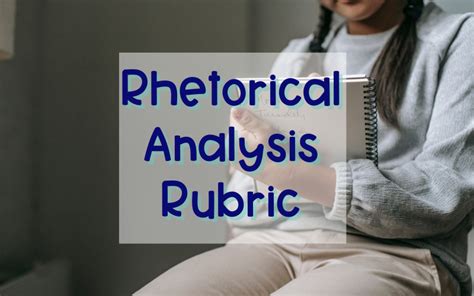Introduction

The Advanced Placement (AP) English Language and Composition exam requires students to analyze a piece of rhetoric effectively. Rhetorical analysis involves examining how language, structure, and style contribute to a text’s meaning and impact. This comprehensive guide will provide step-by-step instructions, useful tips, and ample resources to help you excel in your AP Lang rhetorical analysis essay.
The AP Lang rhetorical analysis essay assesses your ability to:
- Identify and analyze the rhetorical devices used in a text
- Explain how these devices contribute to the text’s purpose and audience
- Evaluate the effectiveness of the writer’s argument
1. Read and Annotate the Text
Begin by reading the text attentively, highlighting key passages and annotating them with notes on:
- Rhetorical devices (e.g., metaphors, similes, parallelism)
- Structure (e.g., organization, transitions)
- Style (e.g., tone, diction)
2. Identify the Author’s Purpose and Audience
Determine the writer’s intent for writing the text. Is it to persuade, inform, or entertain? Identify the intended audience, considering their demographics, interests, and values.
3. Analyze Rhetorical Devices
Examine the specific rhetorical devices used by the author and explain how they enhance the text’s effectiveness. Consider:
- Metaphor: Comparison of two unlike things without using “like” or “as” to create vivid imagery
- Simile: Comparison of two unlike things using “like” or “as” to convey similarity
- Parallelism: Repetition of similar grammatical structures to create rhythm and emphasis
- Analogy: Comparison of two similar things to illustrate a point
- Hyperbole: Exaggeration for effect
- Understatement: Downplaying the importance of something for effect
4. Evaluate the Effectiveness of the Argument
Assess the writer’s overall argument by considering:
- The strength of the evidence provided
- The clarity of the language used
- The persuasiveness of the appeals made (logos, ethos, pathos)
5. Craft a Thesis Statement
Formulate a clear and concise thesis statement that succinctly summarizes the main idea of your analysis. This statement should include:
- The author’s purpose and audience
- The rhetorical devices used
- How these elements contribute to the text’s effectiveness
- Practice reading and annotating: The more texts you analyze, the better you will become at identifying rhetorical devices.
- Use specific examples: Cite specific passages from the text to support your analysis.
- Organize your essay logically: Divide your essay into clear paragraphs that each focus on a specific aspect of the text.
- Proofread carefully: Ensure that your essay is free of grammatical errors and that your ideas are expressed clearly.
- AP Central: Provides practice tests and scoring guidelines: https://apcentral.collegeboard.org/courses/ap-english-language-and-composition
- Khan Academy: Offers free video lessons and practice questions: https://www.khanacademy.org/test-prep/ap-english-language-and-composition/a/intro-to-rhetorical-analysis
- The Purdue OWL: Provides detailed writing and grammar guides: https://owl.purdue.edu/owl/research_and_citation/apa_style/apa_style_introduction.html
| Rhetorical Device | Definition | Example |
|---|---|---|
| Metaphor | Comparison of two unlike things without using “like” or “as” | “Time is money.” |
| Simile | Comparison of two unlike things using “like” or “as” | “Her eyes were like stars.” |
| Parallelism | Repetition of similar grammatical structures | “We shall not flag or fail. We shall go on to the end. We shall fight in France.” (Winston Churchill) |
| Analogy | Comparison of two similar things to illustrate a point | “The human body is like a machine.” |
| Hyperbole | Exaggeration for effect | “I’m so hungry, I could eat a horse.” |
| Understatement | Downplaying the importance of something for effect | “It was a bit chilly outside.” (on a day when the temperature was below freezing) |
| Appeal | Definition | Example |
|---|---|---|
| Logos | Appeal to logic and reason | “According to a recent study, 90% of smokers develop lung cancer.” |
| Ethos | Appeal to credibility and authority | “The renowned scientist, Dr. Emily Carter, supports this theory.” |
| Pathos | Appeal to emotion | “Imagine the pain and suffering of those affected by this disease.” |
| Rhetorical Mode | Purpose | Example |
|---|---|---|
| Argumentation | To persuade the reader | Political speeches, editorials |
| Exposition | To explain or inform | Textbooks, news articles |
| Narration | To tell a story | Novels, short stories |
| Description | To create a vivid image | Poetry, travelogues |
| Tip | Description |
|---|---|
| Read aloud | Identify awkward phrasing or grammatical errors. |
| Use a spell checker | Catch misspellings and typos. |
| Take breaks | Step away from your essay for a while to return with a fresh perspective. |
| Get feedback | Ask a peer or teacher to review your essay for clarity and organization. |
By following these steps and utilizing the resources provided, you will be well-equipped to craft a powerful and insightful AP Lang rhetorical analysis essay. Remember to analyze the text thoroughly, identify the rhetorical devices used, evaluate the effectiveness of the argument, and present your analysis clearly and persuasively. With consistent practice and dedication, you can achieve success in this challenging task.
